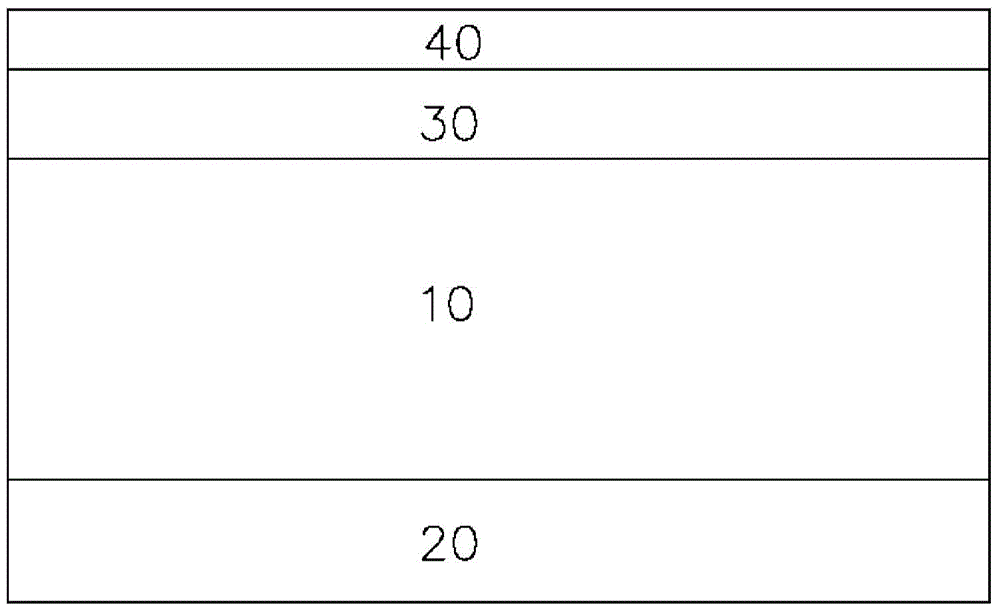Substrate film for transparent electrode film production
A technology of transparent electrode film and transparent electrode layer, which is applied in the direction of cable/conductor manufacturing, circuits, electrical components, etc., and can solve problems such as mechanical damage, inability to develop electrode layers, and cracking of ITO layers
- Summary
- Abstract
- Description
- Claims
- Application Information
AI Technical Summary
Problems solved by technology
Method used
Image
Examples
Embodiment 1
[0055] A semi-cured layer whose curing degree was adjusted to 60% by controlling the light dose was formed on one surface of a 188 μm thick polyester film.
[0056] In this way, the photocurable resin composition used is mixed with 10g of trifunctional acrylate monomer, 10g of trifunctional aliphatic acrylate oligomer, 10g of hexafunctional acrylate oligomer, 2g of 265nm initiator and 68g of acetic acid. Made from ethyl ester. The photocurable composition is dried to a coating thickness of 5μm, and the UV dose applied when forming a cured layer is 600mJ / cm 2 .
[0057] The subsequent process was performed in a similar manner to Comparative Example 1, except that the PEDOT composition of Comparative Example 1 was applied on the surface of the semi-cured layer and then dried to form an electrode layer.
[0058] The X-axis terminal resistance of the manufactured touch unit is 276Ω, and the Y-axis terminal resistance is 575Ω.
[0059] The adhesive force of the electrode layer of the touc...
Embodiment 2
[0061] A fully cured photocurable layer is formed on one surface of a 188μm thick polyester film, and the same resin is applied on the other surface, thereby forming a semi-cured layer with a curing degree of 60% by adjusting the light dose .
[0062] The photocurable resin composition used was mixed with 10g of trifunctional acrylate monomer, 10g of trifunctional aliphatic acrylate oligomer, 10g of hexafunctional urethane acrylate oligomer, 2g of 265nm initiator and 68g Made with ethyl acetate. The photocurable composition is dried to a coating thickness of 5μm, and the UV dose applied when forming a fully cured layer is 600mJ / cm 2 .
[0063] The subsequent process was performed in a similar manner to Comparative Example 1, except that the PEDOT composition of Comparative Example 1 was applied on the surface of the semi-cured layer and then dried to form an electrode layer, and a fully cured layer was formed.
[0064] The X-axis terminal resistance of the manufactured touch unit i...
Embodiment 3
[0067] Example 3 is similar to Example 2, except that the degree of curing of the semi-cured layer is 75%.
[0068] The X-axis terminal resistance of the manufactured touch unit is 265Ω, and the Y-axis terminal resistance is 587Ω.
[0069] The adhesion force of the electrode layer of the touch module manufactured according to ASTM D3359 is 5B (which is evaluated as good), and the change of the terminal resistance after the aging test is measured: the upper template is 6.7%, and the lower template is -6.5%. The haziness of this sample is 1.96%.
PUM
| Property | Measurement | Unit |
|---|---|---|
| thickness | aaaaa | aaaaa |
| electrical resistance | aaaaa | aaaaa |
| electrical resistance | aaaaa | aaaaa |
Abstract
Description
Claims
Application Information
 Login to View More
Login to View More - R&D
- Intellectual Property
- Life Sciences
- Materials
- Tech Scout
- Unparalleled Data Quality
- Higher Quality Content
- 60% Fewer Hallucinations
Browse by: Latest US Patents, China's latest patents, Technical Efficacy Thesaurus, Application Domain, Technology Topic, Popular Technical Reports.
© 2025 PatSnap. All rights reserved.Legal|Privacy policy|Modern Slavery Act Transparency Statement|Sitemap|About US| Contact US: help@patsnap.com

